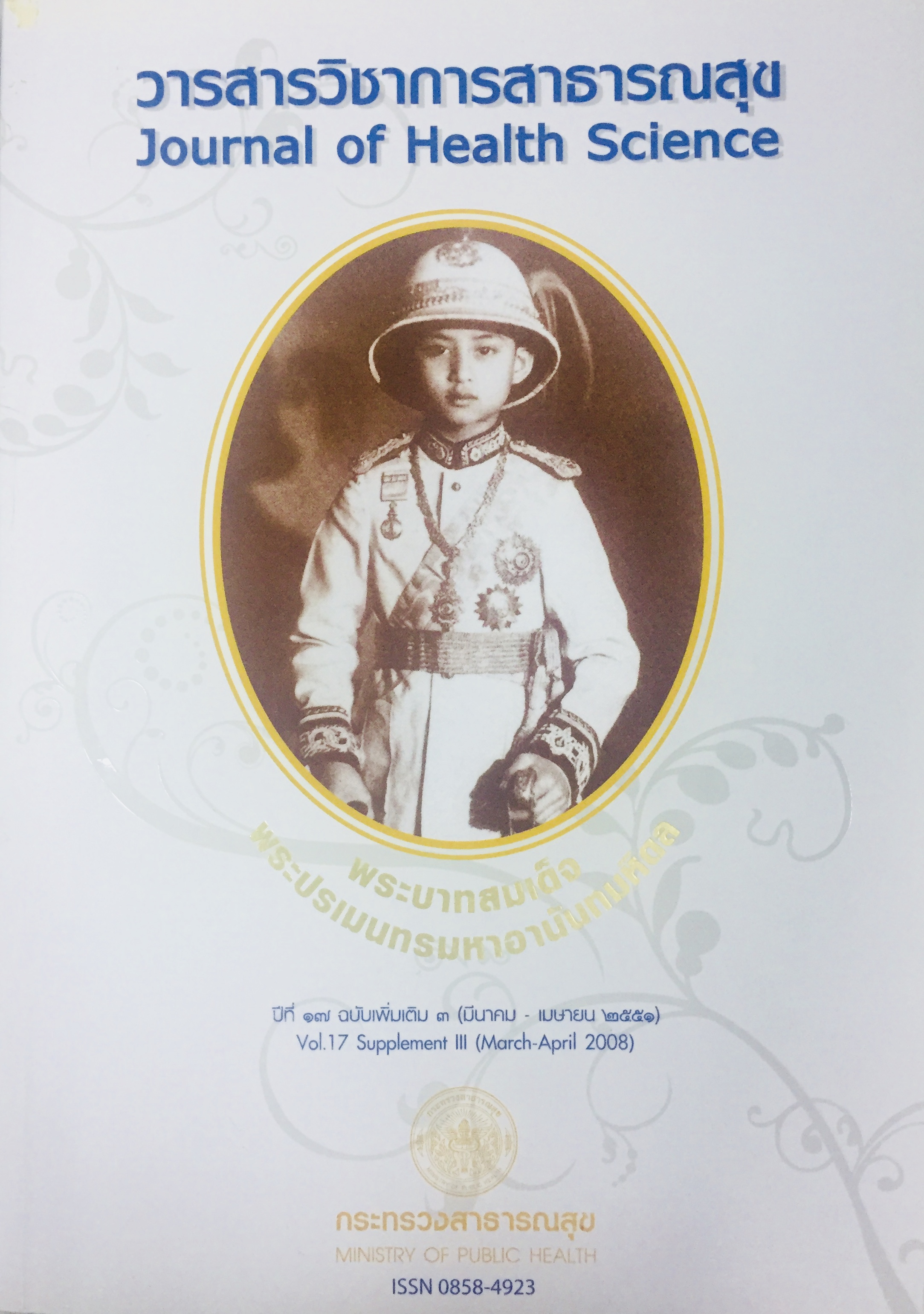อัตราความชุก ปัจจัยเสี่ยง และผลการรักษา โรคหิดในนักเรียนโรงเรียนสุพรรณบุรีปัญญานุกูล
คำสำคัญ:
โรคหิด, ความชุก, ปัจจัยเสี่ยงบทคัดย่อ
การศึกษาเชิงวิเคราะห์แบบไปข้างหน้านี้ ตรวจวิเคราะห์คัดกรอง เพื่อหาอัตราความชุก ปัจจัยเสี่ยง และผลการรักษาโรคหิดในนักเรียนโรงเรียนสุพรรณบุรีปัญญานุกูล จำนวน 414 คน เป็นเวลา 3 เดือน ตั้งแต่เดือนมกราคม ถึง มีนาคม 2551 โดยการซักประวัติ ตรวจร่างกายและขูดรอยโรคไปตรวจหาตัวหิด ไข่หิด หรือ มูลหิด ด้วยกล้องจุลทรรศน์ ข้อมูลที่ได้นำมาวิเคราะห์หาปัจจัยเสี่ยงที่สัมพันธ์กับการเกิดโรคหิด สิ้นสุดการ ติดตามผล พบว่ามีนักเรียนเป็นโรคหิด จำนวน 124 คน คิดเป็นอัตราความชุก ร้อยละ 27.9 อัตราส่วนเพศชายต่อเพศหญิงเท่ากับ 1.6 ต่อ 1 พบผู้ป่วยช่วงอายุ 6-10 ปี ศึกษาอยู่ชั้นประถมและมีภูมิลำเนาอยู่ในกรุงเทพและภาคกลางเป็นโรคหิดมากที่สุด ระยะเวลาที่มีอาการก่อนมาพบแพทย์อยู่ในช่วง 3 สัปดาห์ อาการนำคือ คันมากตอนกลางคืน อาการแสดงตรวจพบตุ่มคันมากที่สุด ตำแหน่งที่พบบ่อยที่สุด คือ ง่ามนิ้วมือ ท้องและอวัยะเพศ ส่วนใหญ่ไม่ทราบว่าติดโรคมาจากไหนและบางส่วนติดจากเพื่อนที่โรงเรียน ผลการรักษาด้วย 1% Gamma benzene hexachloride ครั้งแรกพบผู้ป่วยหายร้อยละ 61 ครั้งที่ 2 (1 สัปดาห์ถัดจากครั้งแรก)หายร้อยละ 73 และผู้ป่วยทุกคนหายจากโรคหิดทั้งหมดใน 4 สัปดาห์ถัดจากครั้งแรก นักเรียนโรงเรียน สุพรรณบุรีปัญญานุกูลเป็นโรคหิดค่อนข้างมากจากปัจจัยเสี่ยงที่เกี่ยวกับอนามัยส่วนบุคคลไม่ดี(p<0.001, OR 304.9, 95%CI 122.9, 756.2) และความแออัดของสถานที่อยู่อาศัย(p=0.001, OR 83.1, 95%CI 23.3, 295.4) การอบรมให้ความรู้แก่บุคลากร และ มีนโยบายที่ชัดเจนในการควบคุม เฝ้าระวังโรค ให้การวินิจฉัยพร้อมทั้งรักษาอย่างรวดเร็วและมีประสิทธิภาพ จะช่วยลดอัตราเสี่ยงจากการเป็นโรคหิดซ้ำ และป้องกันการแพร่กระจายของโรคหิดสู่ครอบครัวและชุมชน
Downloads
ดาวน์โหลด
เผยแพร่แล้ว
วิธีการอ้างอิง
ฉบับ
บท
การอนุญาต
ลิขสิทธิ์ (c) 2018 วารสารวิชาการสาธารณสุข

This work is licensed under a Creative Commons Attribution-NonCommercial-NoDerivatives 4.0 International License.







